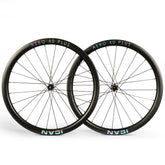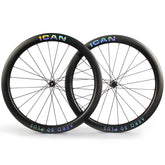How to choose the right tires and wheels
It is common knowledge in the road cycling community that narrower tires are faster than wider tires. A narrow tire rolls faster than a wide tire, easy right?
For many years the standard width for a road bike was 23mm, and many racers used tires 21mm wide or even narrower.
The situation has now changed, in recent years we have noticed a strong trend towards wider tires and wider road bike wheelsets. Many drivers have already switched to 25 mm or even wider tires.
Why are so many riders now opting for wider wheels?
How should we choose the right tires and wheels? We will find out all this in this article!
Choose the wider bike wheelsets
Wider wheels are becoming a new trend for racers. Choosing a wheelset with the right width will add to your riding experience. Why you should have wider wheelsets.
Wider tires have less rolling resistance
When pedaling, we all want our tires to roll as easily as possible, but a certain amount of energy is always lost to rolling resistance. Every tire flexes at the point where it contacts the ground under load, and this flexion is determined by many factors: air pressure, tire width, compounds used, tire casing.
All of these factors combine to create your rolling resistance.
(Contact area of a wide tire)
(Contact area of a narrow tire)
Although a wide tire and a narrow tire have the same contact area, a wide tire is flattened across its width. At the same tire pressure, a narrow tire is flattened over a slimmer but longer contact patch. Because the narrow tire has more deformation, it creates more resistance compared to the wide tire, which has a shorter contact area and therefore rolls better.
Choose a suitable tire type
After thinking about tire width, the next decision is: what type of tire to use?
When it comes to a road bike, there are three options to choose from: tubular, clincher, and tubeless. All of these types of tires have their advantages and disadvantages, but which tire is right for you?
Tubular tires consist of a complete carcass tube into which a latex tube is sewn. They are considered the fastest type of tire of the three, which is why they are the gold standard for most professional racers.
Unfortunately, there are a few disadvantages. First, tubular tires require a tubular-specific wheelset onto which the tire is bonded. This means you'll probably need to buy a new (expensive) set of wheels.
Secondly, the fact that they are glued is quite inconvenient if you have a puncture and need to replace it.
Finally, research has shown that this type of tire has the highest rolling resistance.
The main advantage of tubular tires comes from their weight, they are significantly lighter than any other tire.
Clincher tires are the most common type of tire and are used on most conventional bicycles. These tires have a bead that hooks into the rim. The bead itself is pressed into the inside of the rim by a tube.
Since this is the most commonly used tire configuration, this is a fairly cost-effective option. There probably won't be a need to buy another set of wheels. Only the tire needs to be replaced if you want to change your configuration. Of course, there is always the risk of a “snakebite” as long as you use tubing.
But let’s not forget, clinchers are easy to use.
Tubeless tires are similar to clincher tires, except they don't have a tube. They have a thicker bead and a sealant inside that keeps everything airtight. The sealant also fills small holes and allows driving with lower tire pressures. This in turn means you have a more comfortable ride. Since there is no hose, the risk of a “snakebite” is eliminated.
Setting up a tubeless system requires some preparation: you'll need rim tape, a tubeless valve, and of course sealant, as well as a little know-how to mount a tubeless tire.
Aero and low profile wheelsets
In recent years we have seen an evolution in road bike wheelsets , particularly carbon disc brake rims.
These become wider both externally and internally to optimally support the cross-sectional profile of the tire. Using a wide tire on a narrow rim creates an unaerodynamic shape. However, if you put the wide tire on a suitable rim, you get a wheel that cuts through the air effortlessly.
With low-profile wheels you can even achieve a better aerodynamic advantage. Because let's be honest: We all want to be faster drivers and will use any help we can to achieve this.
But what about crosswinds, you ask? Aren't aero wheels more susceptible to lateral forces?
Of course, some riders may feel more crosswind than with flatter wheels. But with a little practice, most recreational riders should be able to easily handle wheels up to 65mm deep. An experienced rider should be able to handle even deeper wheels even after a few months.
Wheel design has improved over the years to the point where riding with deep wheels has become easier, even in adverse conditions. There's even the option to ride all year round with a deep tread wheelset.
And when it comes to climbing, aren't lighter wheels with a lower profile better?
In my opinion, this is very controversial: Yes, a wheelset with a deep profile is a little heavier and a little slower on the climbs. But once you get to the other side of the climb you'll notice the difference in these deeper wheels...
Not all drivers drive under the same conditions. Some ride on mixed terrain with occasional climbs, while others spend their time riding uphill. Some drivers always ride on flat and undulating terrain where speed is a priority. Let's not forget that not all drivers have the same reason for driving. Some ride for joy, others for speed, and others for completely different reasons. But for all types of riders, at Icanwheels we have a solution and a wheelset that suits you perfectly.







